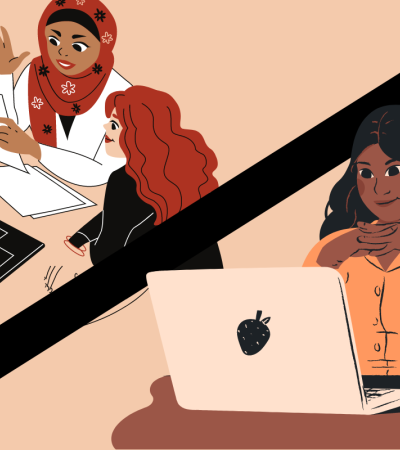Hybrid programming can help libraries a wide range of community members, from people who are wary of COVID exposure to patrons with child care or transportation issues. Hybrid programs can also allow for larger attendance caps and a smoother pivot to a fully virtual program in case of an emergency.
For some programs, however, hybrid might not be the right fit. In the webinar "When To Go Hybrid: Determining Which Format Best Fits Your Program," Melissa Wong, adjunct lecturer in the School of Information Sciences at the University of Illinois at Urbana-Champaign, explored what library programs are conducive to the trending hybrid format.
Watch Wong's webinar recording or read some key takeaways below.
Creating equivalent experiences
When considering offering a hybrid program, it's important to offer an equivalent experience to in-person and online attendees.
First, let's imagine what a hybrid situation might look like. In the library, you may have a presenter at the front of the room speaking to a physical, in-person audience. At the same time, that speaker will be livestreamed — using a camera, microphone, and video-conferencing platform like Zoom — to an online audience.
How can you give a good experience to both your in-person and online attendees? Hybrid should not mean passively watching a livestream if you're sitting at home.
Just like an in-person program has a moderator to welcome the speaker and facilitate a Q&A session, you will need a separate online moderator to do the same for virtual attendees. For smaller events, your online moderator can handle both tech support and Q&A; for larger events, you may need two online moderators, one dedicated to tech issues and the other to Q&A.
To make this set-up work smoothly, think about three key things: visual, audio and audience engagement.
- Visual: You will need a camera that captures your speaker. If a speaker has a podium, this can be as simple as a laptop's built-in camera. Otherwise, you may need to set up a camera in the audience to fully capture the stream. You also need to capture other visuals that are part of the presentation, such as slides, handouts or objects that the speaker may be showing. You may require a second camera to ensure that online viewers don't miss anything.
- Audio: Ensure that you are capturing the speaker loudly and clearly. You can purchase a system with a handheld or wearable mic that will simultaneously enhance sound for the in-person and virtual audiences. Think about any audio that will be coming from your audience, especially if there is a Q&A involved. How will you capture audience questions? You could pass a mic or ask the speaker or moderator to repeat the question into the mic to ensure all participants hear the question.
- Audience engagement: Consider audience participation beyond Q&A sessions and for more complex activities like story times and craft programs. If you are demonstrating how to do a craft and you would normally circulate around the room, this will take more pre-planning and thought to engage virtual participants as well.
Hybrid works well when...
- You have a stationary speaker that requires a single camera.
- The visuals are limited in scope, such as a single set of slides or a predictable cut to something like a read-aloud book.
- Audience participation is limited or structured, like a moderated Q&A, small-group discussion with some in-person groups and online groups, or a polling activity.
- Your speaker is comfortable with the hybrid format.
- Staff support is in place.
What are the best library programs for the hybrid format?
Lectures, panel discussions and author talks are easy for first-time hybrid planners. Poetry readings and concerts are also great options since audience interaction is generally quick or non-existent.
Art classes and maker programs are a little more complex, but they can work well in a hybrid format, especially when they only require common materials that virtual attendees would have at home, or you can provide take-home kits in advance.
If you're interested in reaching teens and want a gaming night, a lot of teens are already online! Have a hybrid program where some teens come into the library to play games together and have a Discord link ready to reach the kids at home as a way for all participants to connect with each other.
Not everything will be a hybrid success
If you feel like a certain program won't be successful in a hybrid format, or you are concerned that you will not be able to effectively engage both groups of attendees, you may be better off offering in-person only or virtual only. You can also try offering duplicate programs in varied formats. For example, a tech workshop might be easier to offer on two occasions — once in person and once online — to allow instructors to focus on one audience at a time.
Have you run a successful hybrid program? What kind of program was it? Let us know in the comments.
See the full list of hybrid programming webinars and articles from this series.
Funding for this article has been provided by the National Endowment for the Humanities (NEH) as part of the American Rescue Plan: Humanities Organization Grant.



